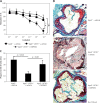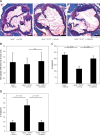Impact of peroxisome proliferator-activated receptor γ on angiotensin II type 1 receptor-mediated insulin sensitivity, vascular inflammation and atherogenesis in hypercholesterolemic mice
- PMID: 26322101
- PMCID: PMC4548041
- DOI: 10.5114/aoms.2015.53309
Impact of peroxisome proliferator-activated receptor γ on angiotensin II type 1 receptor-mediated insulin sensitivity, vascular inflammation and atherogenesis in hypercholesterolemic mice
Abstract
Introduction: The angiotensin II type 1 receptor (AT1R) and the peroxisome proliferator-activated receptor γ (PPARγ) have been implicated in the pathogenesis of atherosclerosis. A number of studies have reported that AT1R inhibition or genetic AT1R disruption and PPARγ activation inhibit vascular inflammation and improve glucose and lipid metabolism, underscoring a molecular interaction of AT1R and PPARγ. We here analyzed the hypothesis that vasculoprotective anti-inflammatory and metabolic effects of AT1R inhibition are mediated by PPARγ.
Material and methods: Female ApoE(-/-)/AT1R(-/-) mice were fedwith a high-fat and cholesterol-rich diet and received continuous treatment with the selective PPARγ antagonist GW9662 or vehicle at a rate of 700 ng/kg/min for 4 weeks using subcutaneously implanted osmotic mini-pumps. Additionally, one group of female ApoE(-/-) mice served as a control group. After treatment for 4 weeks mice were sacrificed and read-outs (plaque development, vascular inflammation and insulinsensitivity) were performed.
Results: Using AT1R deficient ApoE(-/-) mice (ApoE(-/-)/AT1R(-/-) mice) we found decreased cholesterol-induced endothelial dysfunction and atherogenesis compared to ApoE(-/-) mice. Inhibition of PPARγ by application of the specific PPARγ antagonist GW9662 significantly abolished the anti-atherogenic effects of AT1R deficiency in ApoE(-/-)/AT1R(-/-) mice (plaque area as % of control: ApoE(-/-): 39 ±5%; ApoE(-/-)/AT1R(-/-): 17 ±7%, p = 0.044 vs. ApoE(-/-); ApoE(-/-)/AT1R(-/-) + GW9662: 31 ±8%, p = 0.047 vs. ApoE(-/-)/AT1R(-/-)). Focusing on IL6 as a pro-inflammatory humoral marker we detected significantly increased IL-6 levels in GW9662-treated animals (IL-6 in pg/ml: ApoE(-/-): 230 ±16; ApoE(-/-)/AT1R(-/-): 117 ±20, p = 0.01 vs. ApoE(-/-); ApoE(-/-)/AT1R(-/-) + GW9662: 199 ±20, p = 0.01 vs. ApoE(-/-)/AT1R(-/-)), while the anti-inflammatory marker IL-10 was significantly reduced after PPARγ inhibition in GW9662 animals (IL-10 in pg/ml: ApoE(-/-): 18 ±4; ApoE(-/-)/AT1R(-/-): 55 ±12, p = 0.03 vs. ApoE(-/-); ApoE(-/-)/AT1R(-/-) + GW9662: 19 ±4, p = 0.03 vs. ApoE(-/-)/AT1R(-/-)). Metabolic parameters of glucose homeostasis (glucose and insulin tolerance test) were significantly deteriorated in ApoE(-/-)/AT1R(-/-) mice treated with GW9662 as compared to vehicle-treated ApoE(-/-)/AT1R(-/-) mice. Systolic blood pressure and plasma cholesterol levels were similar in all groups.
Conclusions: Genetic disruption of the AT1R attenuates atherosclerosis and improves endothelial function in an ApoE(-/-) mouse model of hypercholesterolemia-induced atherosclerosis via PPARγ, indicating a significant role of PPARγ in reduced vascular inflammation, improvement of insulin sensitivity and atheroprotection of AT1R deficiency.
Keywords: angiotensin II type 1 receptor; atherosclerosis; inflammation; insulin sensitivity; peroxisome proliferator-activated receptor γ.
Figures




Similar articles
-
AT1-receptor-deficiency induced atheroprotection in diabetic mice is partially mediated via PPARγ.Cardiovasc Diabetol. 2013 Feb 1;12:30. doi: 10.1186/1475-2840-12-30. Cardiovasc Diabetol. 2013. PMID: 23374104 Free PMC article.
-
GW9662, a peroxisome proliferator-activated receptor gamma antagonist, attenuates the development of non-alcoholic fatty liver disease.Metabolism. 2022 Aug;133:155233. doi: 10.1016/j.metabol.2022.155233. Epub 2022 May 30. Metabolism. 2022. PMID: 35654114
-
The angiotensin receptor blocker, telmisartan, reduces and stabilizes atherosclerosis in ApoE and AT1aR double deficient mice.Biomed Pharmacother. 2010 Dec;64(10):712-7. doi: 10.1016/j.biopha.2010.09.014. Biomed Pharmacother. 2010. PMID: 20970951
-
Thiazolidinedione-independent activation of peroxisome proliferator-activated receptor γ is a potential target for diabetic macrovascular complications.J Diabetes Investig. 2012 Feb 20;3(1):11-23. doi: 10.1111/j.2040-1124.2011.00182.x. J Diabetes Investig. 2012. PMID: 24843540 Free PMC article. Review.
-
Mechanistic Insight into PPARγ and Tregs in Atherosclerotic Immune Inflammation.Front Pharmacol. 2021 Sep 29;12:750078. doi: 10.3389/fphar.2021.750078. eCollection 2021. Front Pharmacol. 2021. PMID: 34658891 Free PMC article. Review.
Cited by
-
C-reactive protein levels predict systolic heart failure and outcome in patients with first ST-elevation myocardial infarction treated with coronary angioplasty.Arch Med Sci. 2017 Aug;13(5):1086-1093. doi: 10.5114/aoms.2017.69327. Epub 2017 Aug 3. Arch Med Sci. 2017. PMID: 28883850 Free PMC article.
-
Genetic disruption of multidrug resistance-associated protein 1 improves endothelial function and attenuates atherosclerosis in MRP1-/- LDLr-/- double knockout mice.Arch Med Sci. 2017 Jun;13(4):930-936. doi: 10.5114/aoms.2017.68239. Epub 2017 Jun 12. Arch Med Sci. 2017. PMID: 28721160 Free PMC article.
-
Effects of Statins on Renin-Angiotensin System.J Cardiovasc Dev Dis. 2021 Jul 9;8(7):80. doi: 10.3390/jcdd8070080. J Cardiovasc Dev Dis. 2021. PMID: 34357323 Free PMC article. Review.
References
-
- Nickenig G, Harrison DG. The AT(1)-type angiotensin receptor in oxidative stress and atherogenesis: part I: oxidative stress and atherogenesis. Circulation. 2002;105:393–6. - PubMed
-
- Nickenig G, Baumer AT, Temur Y, Kebben D, Jockenhovel F, Bohm M. Statin-sensitive dysregulated AT1 receptor function and density in hypercholesterolemic men. Circulation. 1999;100:2131–4. - PubMed
-
- Warnholtz A, Nickenig G, Schulz E, et al. Increased NADH-oxidase-mediated superoxide production in the early stages of atherosclerosis: evidence for involvement of the renin-angiotensin system. Circulation. 1999;99:2027–33. - PubMed
-
- Wassmann S, Nickenig G. Pathophysiological regulation of the AT1-receptor and implications for vascular disease. J Hypertens Suppl. 2006;24:S15–21. - PubMed
-
- Turnbull F. Blood Pressure Lowering Treatment Trialists’ Collaboration. Effects of different blood-pressure-lowering regimens on major cardiovascular events: results of prospectively-designed overviews of randomised trials. Lancet. 2003;362:1527–35. - PubMed
LinkOut - more resources
Full Text Sources
Other Literature Sources
Miscellaneous
